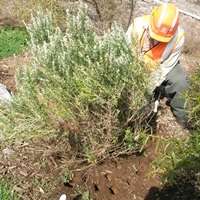Breaking new ground on restoring healthy soil

(Phys.org) —Researchers from The University of Western Australia, working with Alcoa of Australia, are breaking new ground on finding ways to transform bauxite residue into healthy soils.
Rehabilitating bauxite residue is challenging because it's typically highly alkaline and saline, and contains very little organic matter, nutrients or microorganisms, all of which are vital ingredients for plants to grow.
The research team led by Dr Natasha Banning from the UWA School of Earth and Environment found that adding a combination of green waste compost and fertiliser to the bauxite residue sand improves its rehabilitation potential and its capacity to support plants. The team also investigated how microorganisms behave in bauxite residue sand and their influence on nutrient availability such as nitrogen.
"Adding green waste compost to bauxite residue sand improved plant growth because it increased the amount of water stored in residue sands. The compost also added nutrients for the plants to use and increased the amount of microorganisms in the residue," Dr Banning explained.
The research published in Ecological Engineering has direct application to understanding rehabilitation performance which can be applied globally to other residue storage areas under a wide range of environmental conditions.
Alcoa of Australia is a major alumina producer globally with three facilities in Western Australia that refine bauxite ore into alumina. Alcoa has an active research group working collaboratively with local universities to develop best practice methods to store and remediate bauxite residues.
"Alcoa is committed to ensure that areas used to store bauxite residue are properly managed and remediated during the operational life of the refinery and following closure," Senior Research Scientist at Alcoa Dr Ian Phillips said. "This collaborative research will help Alcoa to develop best-practice strategies for rehabilitating these areas. Importantly, if we can work out ways to increase the rate of in-situ remediation of our residue deposits, then we can reduce our long term environmental impact."
More information: Paper: www.sciencedirect.com/science/ … ii/S0925857413004588
Journal information: Ecological Engineering
Provided by University of Western Australia



















